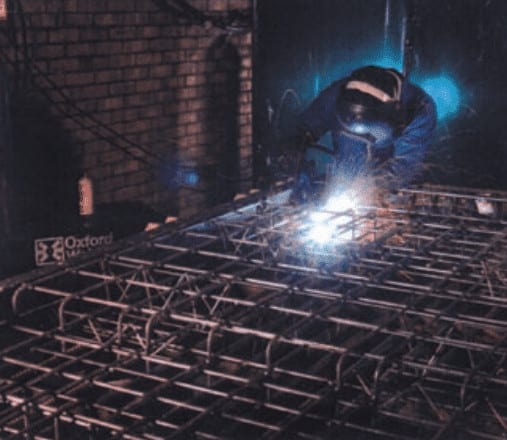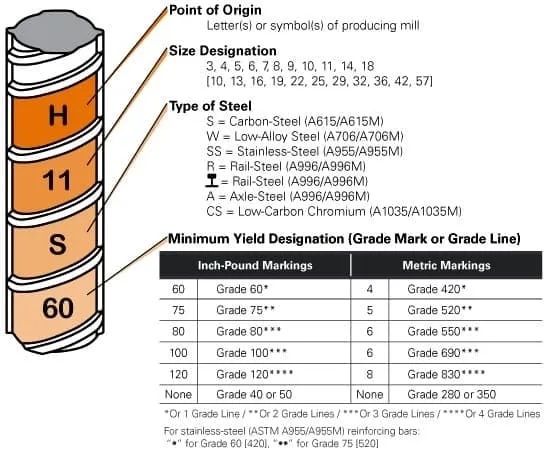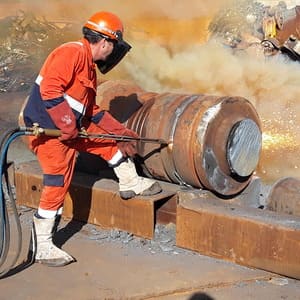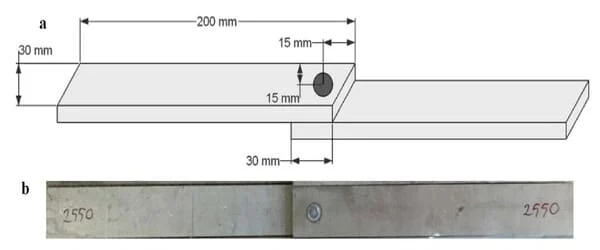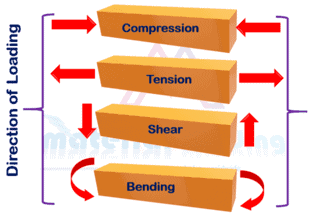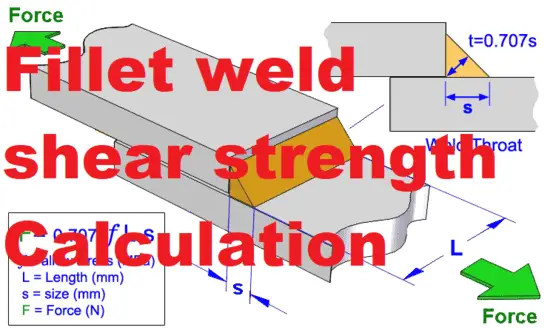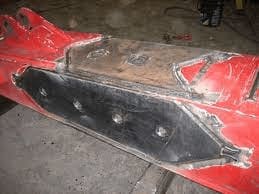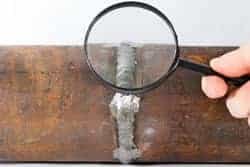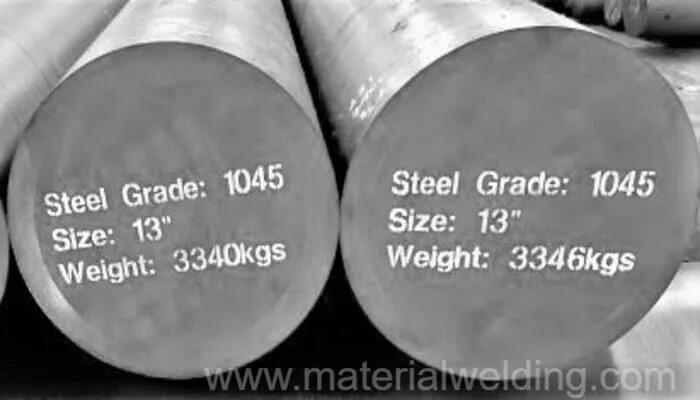Rebar Welding or Reinforcement Bar Steel
Knowing how to weld Rebar or reinforcement bars is very important to ensure the integrity of the structure. As we know, Concrete is an artificial stone that results from a mixture of cement, aggregates, and water by hardening the cement-water mixture.
Concrete has high compressive strength but low tensile strength and shear strength. To make concrete withstand these tensile and shear stresses, it is mandatory to use a steel bar or rebars called reinforcement steel. The steel used for this purpose is called reinforcing steel.
The material specifications for reinforcing bars are ASTM A 615, A 616, and A 617. These standards only specify the mechanical properties of the material and chemical compositions are not given.
As we know that material chemistry is important for material weldability based on its carbon equivalent for example in the case of carbon steel and low alloy steels, you may find reinforcement bars conforming to the above standard but not possible to weld them (Poor weldability).
The rebar material hence must be weldable before incorporating into the design with welding requirements.
Why do we need Weld Rebar?
A reinforcing bar, or rebar, is a common steel reinforcing bar used in concrete construction. Weld Rebar offers a number of advantages over other methods of attaching rebar to concrete.
One of the primary benefits of rebar welding is that it creates a very strong bond between the rebar and the concrete. The heat from the welding process melts the surface of the rebar and the concrete, creating a solid weld. This weld is much stronger than any mechanical connection could ever be.
Another advantage of welding rebar is that it is a very fast and efficient process. A welder can easily weld multiple pieces of rebar together in a short amount of time. This can save time on the construction site and reduce labor costs.
Finally, welding rebar is a relatively simple process that can be learned by anyone with basic welding skills.
Materials Specifications for Rebar or Reinforcement Bar
ASTM A615 , ASTM A 616, and ASTM A 617, ASTM A706, DIN 488, DIN EN 10080
Code/ Standard for Reinforcement Bar Welding/ Rebar Weld
- BS 7123:1989 Metal arc welding of steel for concrete reinforcement
- BS 5135:1984 Process of welding of carbon and carbon-manganese steels
- AWS D 12.1
- ACI CODE-318-19: Building Code Requirements for Structural Concrete and Commentary
- ISO 17660-1:2006 Welding — Welding of reinforcing steel — Part 1: Load-bearing welded joints
- BS 8548:2017 Guidance for arc welding of reinforcing steel
Welding Electrode/ Wire for Rebar or Reinforcement Bar
Most of the rebar materials are carbon-manganese bases. Welding can be carried out using ER70S-6 when welding with the GMAW process. E7018 or E6013 types of electrodes are mostly used with shielded metal arc welding or the Stick welding/ SMAW welding process.
AWS D1.4 (Structural Welding Code – Reinforcing Steel) Table 5.1 specifies the welding rod to be used for rebar welding.
For example, When using ASTM A615 Gr. 60 reinforcement bar, the stick welding (SMAW) can be carried out using a 90ksi rod (e.g. E9018, E9015, etc.).
TIG or MIG/ FCAW welding can be done using ER90S-G or E90C-XXX. In the case of dissimilar materials, the rebar having the higher strength shall be considered for the welding rod selection.
Assume, a weld joint between ASTM A706 Gr. 60 to ASTM A615 Gr. 60 materials. The electrode selection shall be based on the ASTM A615 (90 ksi) as it is having a higher strength compared to ASTM A706 material (80ksi).
A706 rebar welding
A706 Rebar welding shall be carried out using Stick Welding or MIG welding or flux core welding. The stick welding of A706 rebar is made using E8018-G, E8015-G or E80816-G rods.
MIG welding of A706 rebar is carried out using ER80S-G MIG Wire. Similarly, Flux cored welding of A706 rebar is done using E80T1-C (E8XTX-X) type cored wire. Welding preheat temperature for A706 rebar depends on the carbon equivalent of the rebar and its thickness and should be done as follow:
- Upto 0.40% Carbon Equivalent: No preheat
- From 0.40% to 0.65% Carbon Equivalent: a preheat in the range of 200°F to 300°F
- Above 0.65% Carbon Equivalent: a preheat of 400– 500°F
Is A615 rebar weldable?
Yes, A615 rebar is weldable. Welding of A615 rebar is carried out using stick welding, MIG welding and flux cored arc welding.
The recommended welding consumables for A615 rebar welding are:
- For stick welding of A615 Grade 40, & Grade 300 welding: E7015, E7016, E7018, E7028
- For MIG welding of A615 Grade 40, & Grade 300 welding: ER70S-6, ER70S-2
- For Flux cored welding of A615 Grade 40, & Grade 300 welding: E71T-1C, E71T1-M
- For stick welding of A615 Grade 60, & Grade 420 welding: E9018-G
- For MIG welding of A615 Grade 60, & Grade 420 welding: ER90S-G
- For Flux cored welding of A615 Grade 60, & Grade 420 welding: E9XTX-X
- For stick welding of A615 Grade 75, & Grade 520 welding: E10018-M, E10015-X, E10016-X
- For MIG welding of A615 Grade 75, & Grade 520 welding: ER100S-G
- For Flux cored welding of A615 Grade 75, & Grade 520 welding: E10XTX-X
A706 weldable rebar
A706 Weldable rebar welding is carried out using E8018-G or ER80S-G type welding wire rods.
European/ ISO standards for Rebar Welding
Reinforcement steel (rebar) welding or Rebar Welding can be done according to the DIN EN ISO 17660 using the following welding processes:
- Stick (SMAW) Welding
- MAG Welding
- FCAW Welding
- Resistance spot welding
- Pressure butt welding
- Projection Welding
- Friction Welding
- Oxy-fuel gas pressure welding
Filler wires/ welding rods should be matched with the respective reinforcing steel and steel materials in respect to their mechanical properties. As per ISO 17660, only CE-approved and certified welding consumables shall be used for rebar welding.
For load-bearing welded joints the minimum yield strength of the welding rod must be 70% of the yield strength of the rebar material. For load-bearing butt welded joints, the minimum yield strength of the welding rod must be equal to or higher than the yield strength of the rebar material.
Selection of Welding Process for Reinforcement Bar Welding
The welding processes for pre-assembly of reinforcement bar welding or Weld Rebar are:
- Stick (SMAW) Welding
- MAG Welding
- FCAW Welding
- Resistance spot welding
- Pressure butt welding
- Projection Welding
- Friction Welding
- Oxy-fuel gas pressure welding
Welding Procedure for Reinforcement Rar or Rebar Welding
The qualification of the WPS is crucial for a good quality reliable rebar weld joint. The qualification of WPS shall be according to the AWS D1.4 (Structural Welding Code – Reinforcing Steel) or AWS D 12.1, Section 4.
For construction according to DIN/EN or ISO standards, the welding procedure qualification shall be made as per the DIN EN ISO 17660-1 for load-bearing joints and DIN EN ISO 17660-2 for Non-load bearing welding joints.
The procedure qualification for British standard shall be according to the BS 7123- MMAW welding of steel for concrete reinforcement.
Best Welding Rod for Rebar Welding
The selection of the welding rod depends on the material of the rebar. An easy guide for the filler wire/ welding rod selection for rebar welding (Reinforcement bar) is given in the AWS D1.4, Table 5.1 based on the material strength.
Hence, the best welding rod for rebar welding depends on the material being welded and its properties. Table 5.1 gives the best welding rod for various grades of reinforcement bars.
Tack Welding of Reinforced Bars or Rebars
The tack length for a rebar weld shall be a minimum of 25 mm or 1 inch and with a throat size of 4 millimeters or 5/32 inches. The weld joint should be similar to the lap joint configuration.
Welding Joint Details for Welding Procedure for Reinforcement Bar or Rebar Welding
A distinction is made between load-bearing and non-load-bearing welding joints (weld Rebar Joints). Load-bearing welding joints serve to transfer force between connected bars.
Non-load bearing protects individual reinforcement components against being replaced or moved. Welding joints can be made both between reinforcing bars and weldable structural steel. Welding joints details for Welding Splice of reinforcing bar for parallel splice, Direct butt splice, and anchorage splice are shown in the below sketches.
In the below sketch various rebar (reinforcement weld) joints are shown as Sleeve Splice, double lap splice, single & double bevel butt, and single V & Double V butt welds.
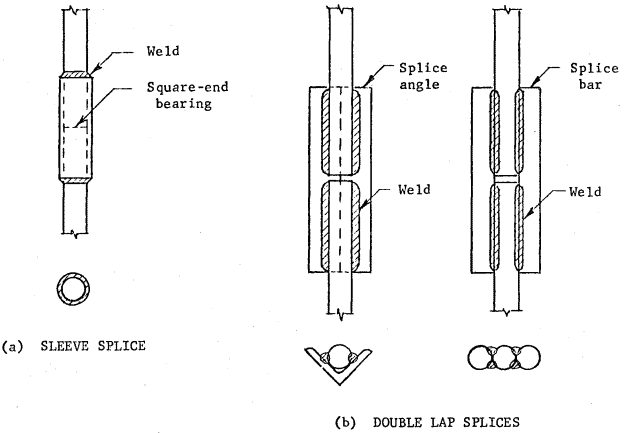
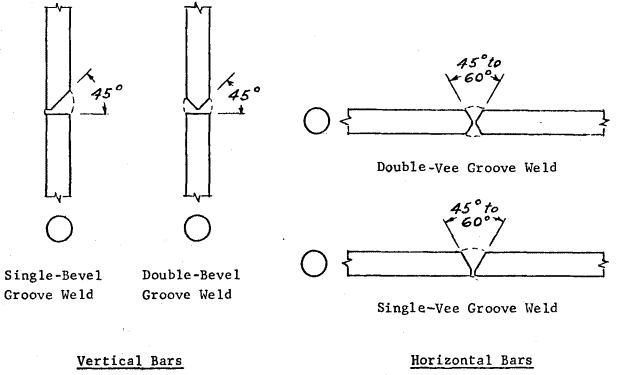
The joints can have also direct butt splice (Double V butt) and anchorage splice (double-sided external fillet weld) as shown in the below sketch.
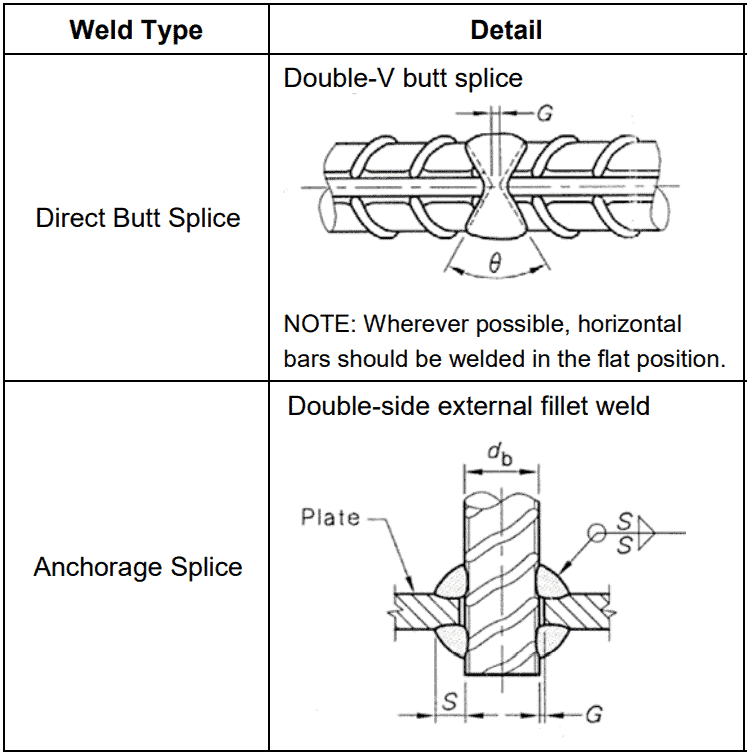
When the welding joints are implemented to DIN EN ISO 17660-1, it can be assumed that the welded joints, with the exception of cruciform joints, can withstand exactly the same degree of stress as the unwelded rod.
Rebar Welding symbol
Rebar joints (reinforcement weld joint) are having a similar weld configuration as a flare V joint or can have a flare bevel joint as well as a fillet weld.
An example of a rebar weld symbol is shown in the below figure where the weld joint is a Single flare V Joint. Other rebar weld joints between rebar and plate are given further in this article with their respective weld symbols.

Welding Rebar to Plate
Welding of rebar to plate is like to usual flare bevel weld joint or fillet weld joints. Welding procedure qualification shall be made according to the applicable code and standard to verify that the joint shall meet the minimum specified requirements.
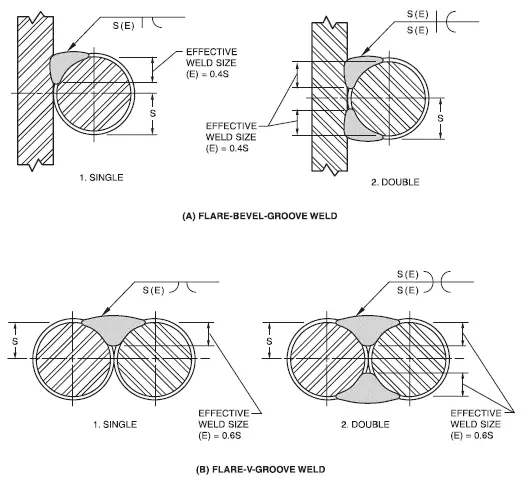
In the below picture, various possible rebar weld configurations between the plate and pipes are shown.
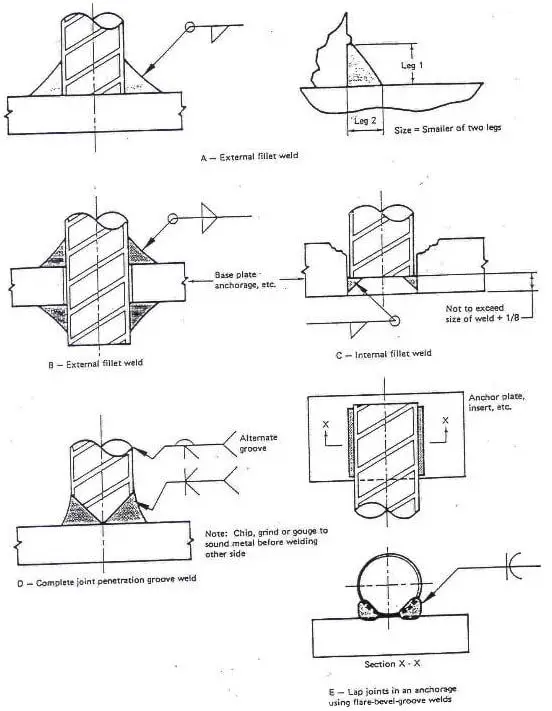
Rebar Welding Certification
Company Certification for rebar or reinforcement steel welding varies from country to country. For example, In the USA, there are no requirements for company certification to perform rebar welding although they have to comply with the applicable construction code requirements (E.g. AWS D1.4).
In Canada, Rebar company certification is as per CSA W186-WELDING OF REINFORCING BARS COMPANY CERTIFICATION. In this standard requirements of certification for Welding of Reinforcement Bars (Rebar) in Reinforced Concrete Construction for steel are given.
In European Union (EU) countries, the company undertaking the reinforcement bar welding work must hold a certificate according to the DIN EN ISO 17660-1 for load-bearing joints or according to DIN EN ISO 17660-2 for non-load bearing joints.
Also, the company must meet the technical welding quality requirements according to DIN EN ISO 3834-3.
Types of Joint for Rebar Welding
The main types of welding joints that are possible with rebar (reinforcement bar) welding are listed below:
- Flare bevel Groove weld (Single & double flare groove)
- Flare V Groove weld
- Direct butt weld (Single V, Double V)
- Indirect butt weld (Single V, Double V)
- Single bevel & Double bevel groove weld
- Lap Joint
- T-Joints
You can find the details of the above weld joint types with their configuration in the AWS D1.1, section 3- Structural Details.
Conclusion:
In conclusion, rebar welding is an important process in construction that helps to create a strong and sturdy foundation for buildings and other structures.
It is a skill that can be learned relatively easily and provides a great way to make some extra money on the side. If you are interested in learning more about rebar welding, be sure to check out some of the resources listed in this article.
